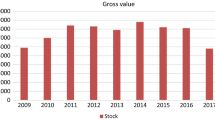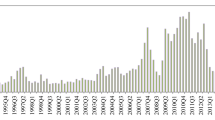Abstract
This study develops a theoretical model examining the relation between housing market strength and brokerage choice. Our model shows that although internal transactions (where both buyer and seller agents are either the same or work for the same firm) have the potential side benefits of higher commission rates and lower search costs, in a strong housing market, brokerage firms are more likely to engage external transactions because of the greater demand for housing. However, when the market weakens, external demand for housing decreases, and brokerage firms become more willing to conduct internal transactions. Furthermore, while an internal transaction tends to occur at the expense of lowering the selling price, we show that it could also be chosen by brokerage firms with higher in-house searching-matching efficiency. This higher in-house efficiency generates a (second-order) counterforce of increasing the price. Hence, our model demonstrates that the housing market has a (partial) self-correction mechanism for the principal-agent incentive misalignment problem, especially when the market strengthens. Conversely, when the market weakens, internal transactions increase and prices decline, which can further weaken the market. Therefore, the equilibrium brokerage choice creates a self-reinforcing mechanism for generating more extreme market conditions. Using the Doubly Robust (DR) estimation method, we present empirical evidence consistent with the model with multiple listing service data from Hampton Roads, Virginia.




Similar content being viewed by others
Notes
See Table B.101 entitled “Balance Sheet of Households and Nonprofit Organizations” in the Federal Reserve’s Flow of Funds Report, which can be found at https://www.federalreserve.gov/releases/z1/20230309/z1.pdf.
Internal transactions are sometimes referred to in the literature as dual agency transactions. However, because terms have historically varied widely, confusion in the current study is avoided by only referring to the three brokerage relationships described in the Introduction.
This proxy is closely related to the realized version of arrival ratio, \(\frac{{k_{in}^{i}{N_{in}}}}{{k_{ex}^{i}{N_{ex}}}}\). Hence, a fair concern is whether a bigger realized ratio truly reflects the superior matching efficiency internally, which should, according to our theory, exhibit a positive price impact for internal transactions. Or does it simply relate to some other unobserved brokerage characteristics that are unrelated to its internal searching-matching ability? As will be shown in the next section, we find significant evidence that brokerage firms (agents) that have a higher internal/external ratio tend to deliver higher prices, especially when it engages in internal transactions.
Some unobserved variables may cause the insignificant trade time coefficients. In the next section, we run a more robust empirical analysis (doubly robust estimator). The trade time coefficients are all positive and significant.
Our two-stage bootstrap models indicate larger bootstrap standard errors than non-bootstrap standard errors, which implies a potential generated regressor issue in our original model.
We thank one anonymous reviewer who pointed out this problem.
References
Anenberg, E. (2016). Information frictions and housing market dynamics. International Economic Review, 57(4), 1449–1479.
Arnold, M. A. (1999). Search, bargaining and optimal asking prices. Real Estate Economics, 27(3), 453–481.
Barwick, P. J., & Pathak, P. A. (2015). The costs of free entry: An empirical study of real estate agents in Greater Boston. RAND Journal of Economics, 46(1), 103–145.
Barwick, P. J., Pathak, P. A., & Wong, M. (2017). Conflicts of Interest and Steering in Residential Brokerage. American Economic Journal: Applied Economics, 9(3), 191–222.
Bian, X., Waller, B. D., & Yavas, A. (2017). Commission splits in real estate transactions. The Journal of Real Estate Finance and Economics, 54(2), 165–187.
Bond, S. A., Hwang, S., Lin, Z., & Vandell, K. D. (2007). Marketing period risk in a portfolio context: Theory and empirical estimates from the UK commercial real estate market. Journal of Real Estate Finance and Economics, 34(4), 447–461.
Cameron, A. C., & Trivedi, P. K. (2022). Microeconometrics Using Stata (2nd ed.). College Station, TX: Stata Press.
Cattaneo, M. D. (2010). Efficient semiparametric estimation of multi-valued treatment effects under ignorability. Journal of Econometrics, 155(2), 138–154.
Chen, J., Glaeser, E. & Wessel, D. (2022). JUE Insight: The (non-) effect of opportunity zones on housing prices. Journal of Urban Economics, 103451
Cheng, P., Lin, Z., & Liu, Y. (2008). A model of time on market and real estate price under sequential search with recall. Real Estate Economics, 36(4), 813–843.
DeFusco, A. A., Nathanson, C. G., & Zwick, E. (2022). Speculative dynamics of prices and volume. Journal of Financial Economics, 146(1), 205–229.
Diamond, D. W. (1989). Reputation acquisition in debt markets. Journal of Political Economy, 97(4), 828–862.
Evans, R., & Kolbe, P. (2005). Homeowners’ repeat-sale gains, dual agency and repeated use of the same agent. Journal of Real Estate Research, 27(3), 267-292.
Forgey, F. A., Rutherford, R. C., & Springer, T. M. (1996). Search and liquidity in single family housing. Real Estate Economics, 24(3), 273–292.
Fu, Y., & Qian, W. (2014). Speculators and price overreaction in the housing market. Real Estate Economics, 42(4), 977–1007.
Gardiner, J. N., Heisler, J., Kallberg, J. G., & Liu, C. H. (2007). The impact of dual agency. The Journal of Real Estate Finance and Economics, 35(1), 39–55.
Gardiner, N., Heisler, J., Kallberg, J., & Liu, C. (2007). The Impact of Dual Agency. Journal of Real Estate Finan Econ, 35, 39–55.
Garmaise, M. J., & Moskowitz, T. J. (2004). Confronting information asymmetries: Evidence from real estate markets. Review of Financial Studies, 17(2), 405–437.
Genesove, D., & Mayer, C. (2001). Loss aversion and seller behavior: Evidence from the housing market. Quarterly Journal of Economics, 116(4), 1233–1260.
Gilbukh, S., & Goldsmith-Pinkham, P. S. (2019). Heterogeneous Real Estate Agents and the Housing Cycle. SSRN 3436797
Goetzmann, W., & Peng, L. (2006). Estimating house price indexes in the presence of seller reservation prices. Review of Economics and statistics, 88(1), 100–112.
Gruber, J., & Owings, M. (1994). Physician financial incentives and cesarean section delivery (No. w4933). National Bureau of Economic Research.
Guren, A. M. (2018). House price momentum and strategic complementarity. Journal of Political Economy, 126(3), 1172–1218.
Hagiu, A., & Jullien, B. (2011). Why do intermediaries divert search? RAND Journal of Economics, 42(2), 337–362.
Han, L., & Hong, S. H. (2016). Understanding in-house transactions in the real estate brokerage industry. RAND Journal of Economics, 47(4), 1057–1086.
Head, A., Lloyd-Ellis, H., & Sun, H. (2014). Search, liquidity, and the dynamics of house prices and construction. American Economic Review, 104(4), 1172–1210.
Hendel, I., Nevo, A., & Ortalo-Magné, F. (2009). The relative performance of real estate marketing platforms: MLS versus FSBOMadison. com. American Economic Review, 99(5), 1878–98
Hong, H., & Stein, J. C. (1999). A unified theory of underreaction, momentum trading, and overreaction in asset markets. Journal of finance, 54(6), 2143–2184.
Hsieh, C. T., & Moretti, E. (2003). Can free entry be inefficient? Fixed commissions and social waste in the real estate industry. Journal of Political Economy, 111(5), 1076–1122.
Huang, J. C., & Palmquist, R. B. (2001). Environmental conditions, reservation prices, and time on the market for housing. Journal of Real Estate Finance and Economics, 22(2–3), 203–219.
Johnson, K. H., Lin, Z., & Xie, J. (2015). Dual agent distortions in real estate transactions. Real Estate Economics, 43(2), 507–536.
Kadiyali, V., Prince, J., & Simon, D. H. (2014). Is dual agency in real estate a cause for concern? Journal of Real Estate Finance and Economics, 48(1), 164–195.
Knight, J. R. (2002). Listing price, time on market, and ultimate selling price: Causes and effects of listing price changes. Real Estate Economics, 30(2), 213–237.
Li, Z., Li, Q., Sun, H., & Sun, L. (2022). Diffused effort, asset heterogeneity, and real estate brokerage. Real Estate Economics, 50(3), 707–742.
Lutz, E. C. & Buechler, S. (2021). The Local Effects of Relaxing Land Use Regulation on Housing Supply and Rents. MIT Center for Real Estate Research Paper, (21/18)
Mehran, H., & Stulz, R. M. (2007). The economics of conflicts of interest in financial institutions. Journal of Financial Economics, 85(2), 267–296.
Micelli, T., Pancak, K., & Sirmans, C. (2000). Restructuring agency relationships in the real estate brokerage industry: An economic analysis. Journal of Real Estate Research, 20(1–2), 31–47.
Ngai, L. R., & Tenreyro, S. (2014). Hot and cold seasons in the housing market. American Economic Review, 104(12), 3991–4026.
Patron, H. E., & Roskelley, K. D. (2008). The effect of reputation and competition on the advice of real estate agents. Journal of Real Estate Finance and Economics, 37(4), 387–399.
Richard, E., & Phillip, K. (2005). Homeowners’ Repeat-Sale Gains, Dual Agency and Repeated Use of the Same Agent. Journal of Real Estate Research, 27(3), 267–292.
Robins, J. M., & Hernán, M. A. (2009). Estimation of the causal effects of time-varying exposures. Longitudinal data analysis, 553, 599.
Rosenbaum, P. R., & Rubin, D. B. (1983). Assessing sensitivity to an unobserved binary covariate in an observational study with binary outcome. Journal of the Royal Statistical Society: Series B (Methodological), 45(2), 212–218.
Sant’Anna, P. H., & Zhao, J. (2020). Doubly robust difference-in-differences estimators. Journal of Econometrics, 219(1), 101–122.
Shapiro, C. (1982). Consumer information, product quality, and seller reputation. Bell Journal of Economics, 20–35
Shapiro, C. (1983). Premiums for high quality products as returns to reputations. Quarterly Journal of Economics, 98(4), 659–679.
Sirmans, C. F., Turnbull, G. K., & Benjamin, J. D. (1991). The markets for housing and real estate broker services. Journal of Housing Economics, 1(3), 207–17.
Słoczyński, T., & Wooldridge, J. M. (2018). A general double robustness result for estimating average treatment effects. Econometric Theory, 34(1), 112–133.
Turnbull, G. K., & Dombrow, J. (2006). Spatial competition and shopping externalities: Evidence from the housing market. Journal of Real Estate Finance and Economics, 32(4), 391–408.
Turnbull, G. K., Dombrow, J., & Sirmans, C. F. (2006). Big house, little house: Relative size and value. Real Estate Economics, 34(3), 439–456.
Wooldridge, J. M. (2010). Econometric analysis of cross section and panel data. MIT press
Yavas, A., & Yang, S. (1995). The strategic role of listing price in marketing real estate: Theory and evidence. Real Estate Economics, 23(3), 347–368.
Yinger, J. (1981). A search model of real estate broker behavior. American Economic Review, 71(4), 591–605.
Author information
Authors and Affiliations
Corresponding author
Ethics declarations
The authors did not receive support from any organization for the submitted work. The authors have no financial or proprietary interests in any material discussed in this article.
Additional information
Publisher's Note
Springer Nature remains neutral with regard to jurisdictional claims in published maps and institutional affiliations.
We are grateful to the Real Estate Information Network Inc. (REIN) in Virginia Beach, VA, who provided the data for this study. We thank editor Brent Ambrose and two anonymous reviewers, who provided insights and expertise that greatly assisted the research. We also thank Sophia Gilbukh and Bertram Steininger, the participants of the 2018 RecapNet Conference and 2019 AREUEA-ASSA, for their suggestions for this project. All errors are our own.
Appendices
A Appendix 1
Here we present the results from the first stage of hedonic regression using the full sample of observations in Table 8.
B Appendix 2 Naive Regression Estimator from Outcome Model
We first present the results from a naive outcome regression model only. The estimation results are displayed in Table 9. Column 1 reflects internal transactions, whereas column 2 reports results for dual agent transactions.
Rights and permissions
Springer Nature or its licensor (e.g. a society or other partner) holds exclusive rights to this article under a publishing agreement with the author(s) or other rightsholder(s); author self-archiving of the accepted manuscript version of this article is solely governed by the terms of such publishing agreement and applicable law.
About this article
Cite this article
Deng, X., Li, Z., Seiler, M.J. et al. Market Strength and Brokerage Choice in Residential Housing. J Real Estate Finan Econ (2023). https://doi.org/10.1007/s11146-023-09969-6
Accepted:
Published:
DOI: https://doi.org/10.1007/s11146-023-09969-6




